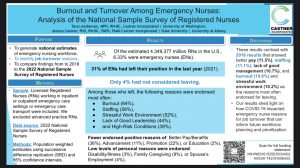A new research analysis co-led by University of Washington doctoral candidate Taryn Amberson finds that burnout and poor working conditions have become the leading reasons emergency nurses are leaving their jobs — a sharp shift from just a few years ago, when better pay and career advancement were the main drivers of turnover.

The study, “Burnout and Turnover Among Emergency Nurses: Analysis of the National Sample Survey of Registered Nurses,” published in the Journal of Emergency Nursing, analyzed national survey data to compare reasons for job turnover among emergency nurses. The results highlight how dramatically the COVID-19 pandemic changed the nursing workforce.
Turnover on the rise
Of an estimated 4.3 million registered nurses in the U.S. in 2021, about 6.3% worked in emergency departments. Nearly one in three (31%) of those emergency nurses left their position that year, and only 4% reported they had not considered leaving.
Among nurses who left, burnout was the most common reason (64%), followed by staffing issues (56%), stressful work environments (52%), poor leadership (44%), and high-risk conditions (39%).

By comparison, in 2018 the most frequently cited reasons for leaving were better pay (11.5%), staffing (11.1%), poor management (10.7%), burnout (10.6%), and stressful work environments (10.2%).
“These results show that the factors driving turnover have shifted from individual motivations to organizational ones,” said Amberson.
A personal motivation to understand the problem
Before beginning her doctoral studies, Amberson spent 10 years working as an emergency nurse. Her own experience during the pandemic shaped the direction of her research.
“My experiences of working in health systems during the COVID-19 pandemic resulted in a desire to better understand how the pandemic impacted nurse work environments and how organizations can support the well-being of their health care workers,” Amberson said. “The messaging I too often heard during the pandemic was, ‘take better care of yourself.’ This research seeks to better understand why emergency nurses are leaving their jobs and what organizations might be able to do about that.”
Organizational factors take center stage
The findings suggest that nurses’ decisions to leave are being driven less by pay and career mobility and more by workplace conditions that feel unsustainable.
“Emergency nurses are vital to the functioning of our healthcare system,” Amberson said. “This study highlights that solutions to the workforce crisis must go beyond individual resilience and instead focus on how organizations can create environments where nurses can thrive.”
Staffing levels, leadership quality, workplace culture, and safety were all identified as key factors associated with turnover. Amberson hopes that by quantifying the impact of these factors, health systems will be better positioned to develop retention strategies that address the root causes of burnout.
A continuing challenge for the healthcare system
High turnover among nurses has significant implications for patient care, team stability, and health system costs. The study’s authors note that addressing burnout and staffing issues will require sustained organizational change — not just short-term fixes.
While the pandemic magnified many of these problems, Amberson’s research shows they remain pressing even as emergency departments return to more typical patient volumes. Her work underscores the need for health care organizations to invest in supportive environments where nurses feel valued and able to provide safe, high-quality care.